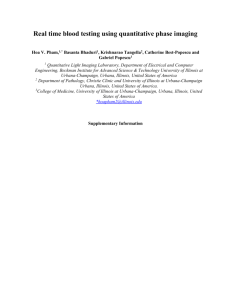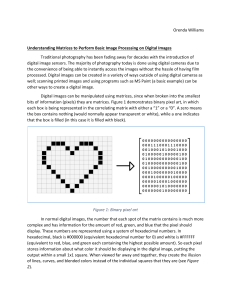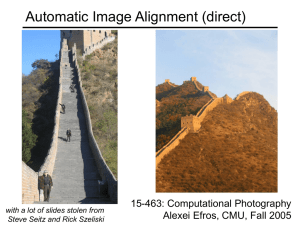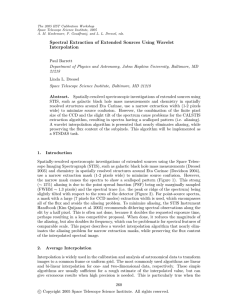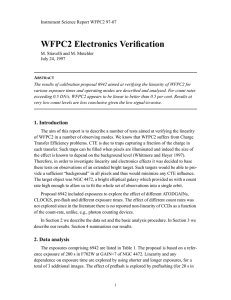High Dynamic Range Imaging: Spatially Varying Pixel Exposures
advertisement
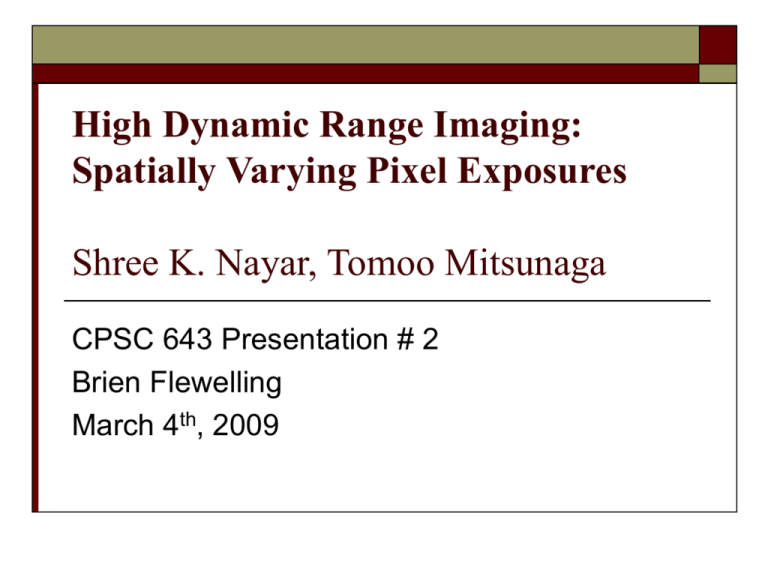
High Dynamic Range Imaging: Spatially Varying Pixel Exposures Shree K. Nayar, Tomoo Mitsunaga CPSC 643 Presentation # 2 Brien Flewelling March 4th, 2009 Overview HDR Imaging Problem Motivation Methods Related Work Where it Started Sequential Images Multiple Detectors, Adaptive Pixel Elements Overview HDR Imaging using Spatially Varying Pixel Exposure The method Image Aquisition Image Reconstruction Experimental Results Conclusions and Future Work High Dynamic Range Imaging: The Idea Perceptible intensity values span a range far greater than can be sampled by a single image. Using Various Techniques, Estimate the camera response function in order to accurately allocate bits in the grayscale to energy levels in the scene. Combining Information from Over Exposure and Under Exposure Consider the projection of the illumination in a scene to be a function of energy rates. Bright/Darker Regions have a higher probability of being over/under exposed for an arbitrary snapshot. It is the combination of various sampling techniques which allow us to display these regions together. Motivation: Why do we care? High Dynamic Range images result in scene representations much more like what is seen by the human eye. Artistic Purposes Visual methods need good “landmarks” if they exist in over/under exposed regions, this can be problematic. In tracking, a region could be over exposed ore under exposed frame to frame. Methods: How to Extract HDRI info Sequential Exposures: Multiple Images at Various Shutter speeds or Iris Settings Solve a subset of pixel correspondences as an array of linear systems Solve for the camera response function Map the results to the image Methods: How to Extract HDRI info Multiple Image Detectors Use optical elements to generate mutiple images sampled by different imagers The images may have varying sensitivities, resolution, or exposure times. More Expensive but can handle moving objects better. Multiple Sensor Elements in Each Pixel Reduces Resolution by a factor of 2 Simple Combination of neighboring elements with different potential well depths. Overall a disregarded approach since the sensor cost is greater and performance gain is not very high. Adaptive Pixel Exposure Vary the pixels sensitivity as a function of the amount of time for its potential well to fill. Feedback System An Interesting and Promising Approach but.. Expensive for large scale chip designs Very sensitive to motion or blur effects in low light scenes Related Work: Where it Started [Blackwell, 1946] H. R. Blackwell. Contrast thresholds of the human eye. Journal of the Optical Society of America, 36:624–643, 1946. Blackwell Studies the variations in perceptible illumination that the human eye detects in a scene. Many patents on HDR CCD sensors in the 1980’s Sequential Methods for HDR Image Generation Early 1990’s Related Work: Sequential Exposures [Azuma and Morimura, 1996], [Saito,1995], [Konishi et al., 1995], [Morimura, 1993], [Ikeda,1998], [Takahashi et al., 1997], [Burt and Kolczynski,1993], [Madden, 1993] [Tsai, 1994]. [Mann and Picard,1995], [Debevec and Malik, 1997] and [Mitsunagaand Nayar, 1999] The final paper extends the estimation to include the radiometric response function of the camera Related Work: Hardware Solutions Multiple Imagers [Doi etal., 1986], [Saito, 1995], [Saito, 1996], [Kimura, 1998],[Ikeda, 1998] Adaptive Pixel Elements [Street, 1998], [Handy, 1986], [Wen, 1989], [Hamazaki, 1996], [Murakoshi, 1994] and [Konishi et al.,1995] [Brajovic and Kanade, 1996]. Spatially Varying Pixel Exposure The SVE (Spatially Varying Exposure Image. Let a 2x2 array of pixels be subject to exposures e0,e1,e2,e3 Let this array be repeated in a mask for the entire image How Does this Increase the DR? How Many Grays? (846) K = # of exposure levels : 4 q = # of quantization levels per pixel: 256 R = Round off function ek = exposure level Spatial Resolution Reduction Not a reduction by a factor of 2! Low exposure level pixels could be noise dominated for dim regions High exposure level pixels could be saturated in bright regions. In general the spatial resolution is not significantly reduced. Image Reconstruction by Aggregation Simple Averaging Convolution with a 2x2 box filter Results in a piecewise linear function which is like a gamma function with gamma > 1 Overall produces good HDR results except at sharp edges Image Reconstruction by Interpolation If sharp features are important, the image brightness value M(i,j) are scaled by their exposures to produce M’(i,j). Remove all underexposed, and saturated pixels Determine the ‘Off-grid’ points from the undiscarded ‘Ongrid’ points by interpolation. The above equation is the cubic interpolation kernel which is used in the least squares estimation for the off grid points Solving for Offgrid Values by the Interpolation Kernel M: 16x1 on-grid brightness values F: 16x49 cubic interpolation elements Mo: 16x1 off-grid brightness values Experimental Results - Simulation Results Future Work Prototype was still being developed Simulation proved useful in the estimation of the nonlinear response function, can it be used to estimate properties of scene objects? Can this be used to estimate/handle motion blur for moving objects? What is an optimal pattern for variation of pixel exposures?







